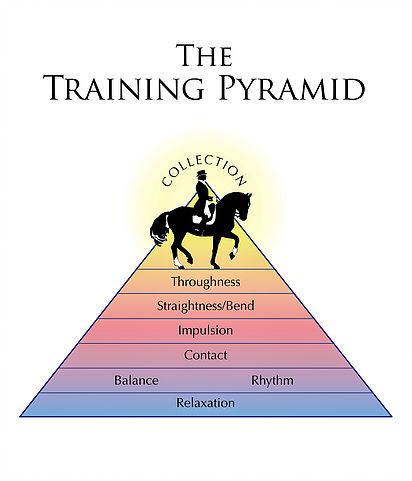
Chakras & the Training Pyramid, Part 5
The throat chakra and straightness/bend.
The fifth chakra is the throat chakra. It is positioned, as you might expect, in the throat region, and represents communication.

This illustration first appeared in the November 1997 issue of Dressage Today magazine (DressageToday.com). Used here with permission.
Nowhere is the idea of communication more critical to our riding success than in the area of straightness and bend, the fifth degree on the seven-step Training Pyramid.
The horse is a prey animal. Physically and mentally, a horse can change focus, direction, speed, and relaxation (along with many other things) in an instant. The ability to panic and bolt helps a horse save its own life, at least in the horse’s mind. Thus an unrelaxed animal can feel quite “squirrelly” under saddle — not really forward, not quite sucking back, but, rather, like every vertebrae is going in a slightly different direction, both laterally and longitudinally, at the same time
The way to correct bend is through correct straightness, and vice versa.
To help our riding partner achieve true straightness, we cannot muddle our communication. For many of us, “muddling” our communication begins between our own ears: we fail to clear our mind before we mount up, so the bazillion thoughts about to-do lists, calls we made, calls we didn’t make, misunderstandings, traffic jams, worries about money and jobs and family and…
You get the idea.
A horse, despite its size and strength, is a very sensitive creature. Your horse can feel a fly. Of course he can sense negative emotions and the thoughts in your mind.
The remedy is to find a repeatable method of systematically cleaning out your head before you mount up.
Perhaps you only need to pause for three deep breaths after you tighten the girth, just before you put your foot in the stirrup. You might repeat a helpful reminder or “mantra” such as, “breathe in blessings, breathe out gratitude” as you breathe.
Or you might want to keep a riding journal in your tack truck, so you can write down your goal for each ride. A sample entry might read something like this: “Tuesday. Today, I want to focus on getting left bend at trot more supple.”
And, as you sit for a couple of minutes, visualizing in your mind what exercises you’ll utilize to help your horse’s left bend, and the chatter from your day starts to reenter your mind, you can mentally weed out the thoughts you don’t want, Marie Kondo style: “My colleague was a jerk today.” WEED! Out! Refocus on left bend exercises. “I need to wash and store my horse’s winter blankets.” WEED! Out! Refocus on left bend exercises.
So that, by the time you ready to mount up, your mind is clear on one and only one goal: Today, I want to focus on getting left bend at trot more supple.
That creates clear thinking, which creates clear communication.
And clear communication will help your horse focus on moving forward in a relaxed manner, in rhythm, happily on the contact (because you’re doing such a great job on clear communication, yay, you and your relaxed throat chakra!), with impulsion, and he’s traveling straight, even while bending whenever you ask for him to bend.
Straightness is the horse’s body’s ability to move as one cohesive unit, whatever gait or direction of travel or bend he is going. Even reinback at speed in western riding should be done with “straightness.”
And in order to move in one cohesive unit, clear communication is vital.






Leave a Comment